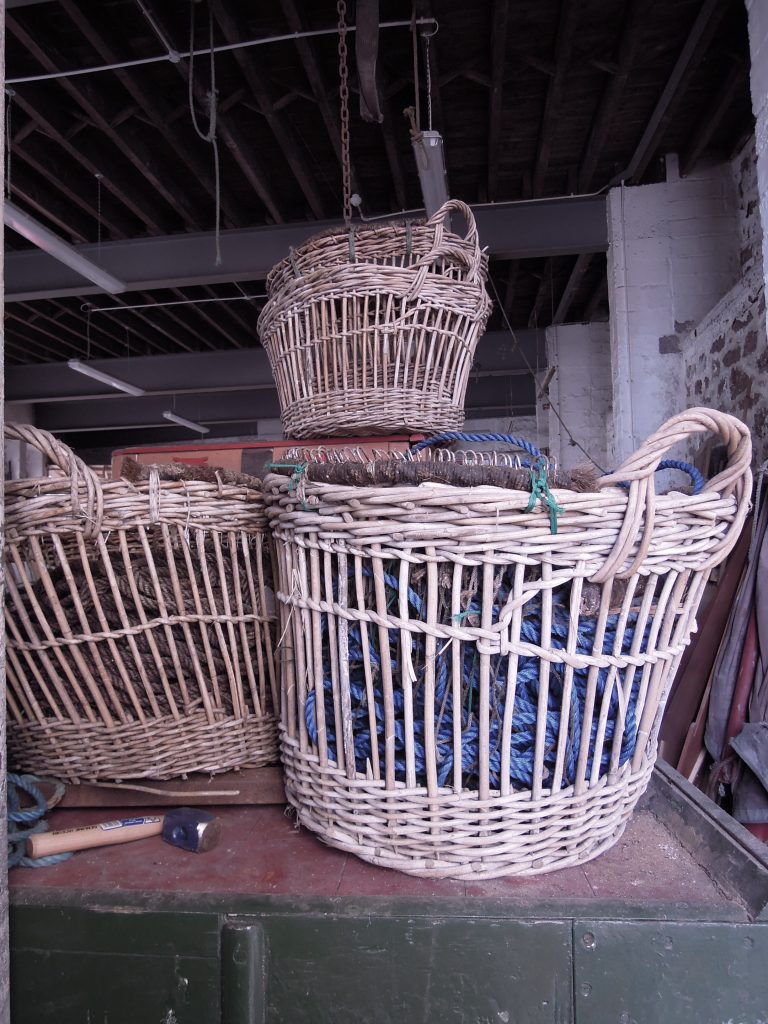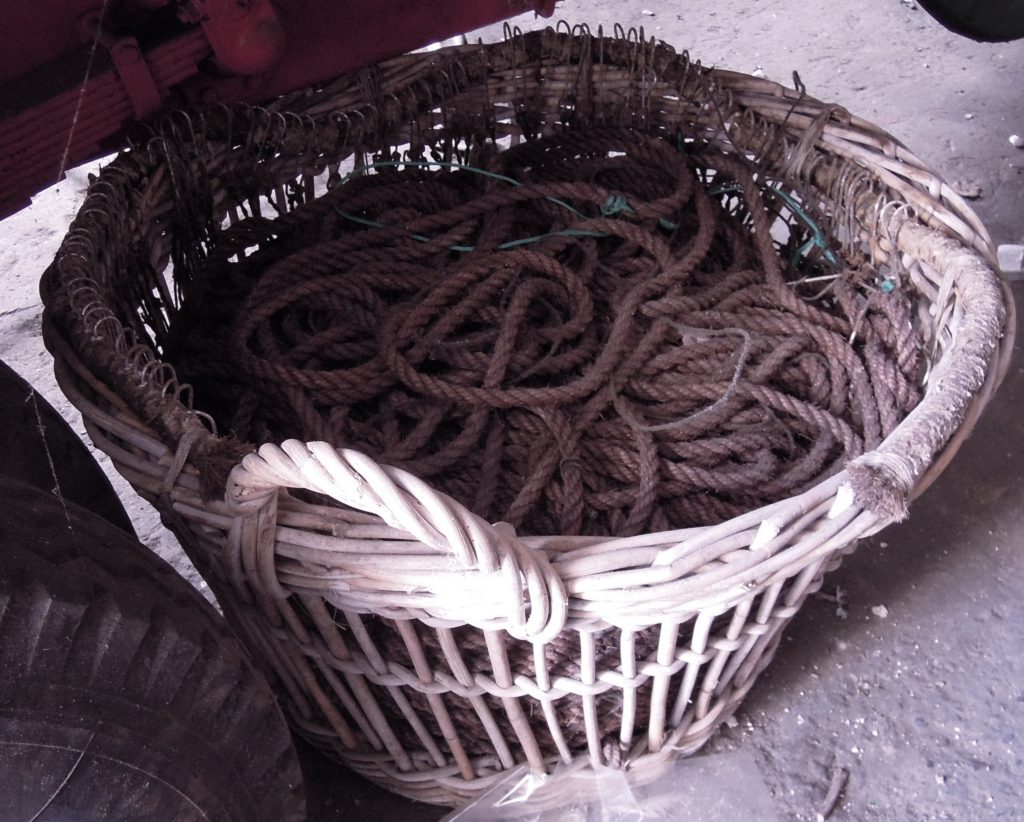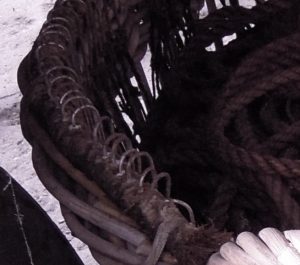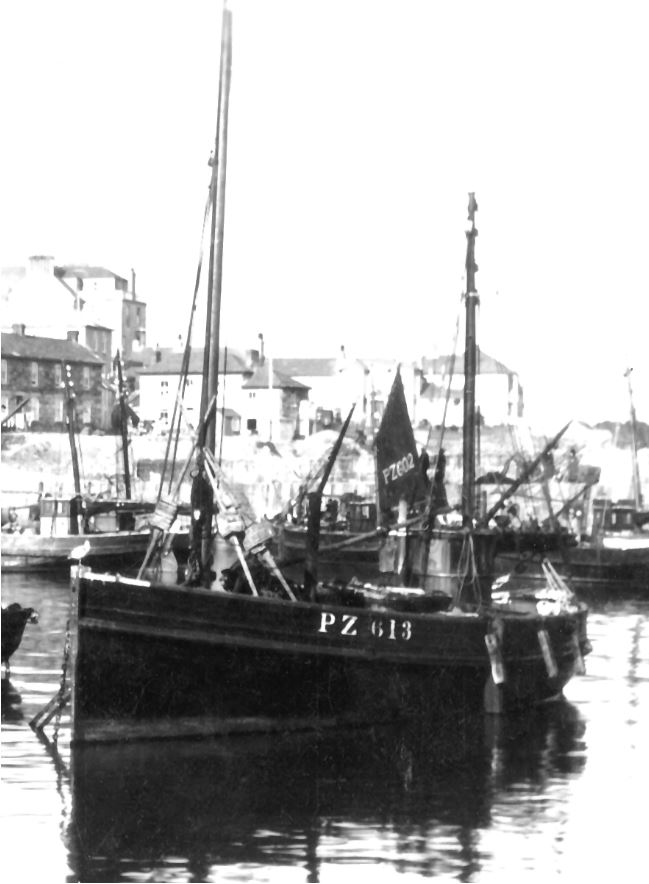Orion – PZ.613 : 1916-1935
Ex – Albania – PZ.613 : 1897-1916
Hawa Dilli – PZ.613 : 1935-1962.
In the Summer of 1916 the Newlyn lugger Albania was acquired by the brothers Richard (46) and Nicholas (43) Humphrys of Mousehole, and they converted her into an auxiliary lugger, with the installation of two Kelvin engines, having a combined power of 50 h.p. Under their joint ownership she was re-registered at the Penzance Custom House on August 16th, 1916, as the Orion, but still carrying the fishing number PZ.613.1 Under this registration her dimensions remained essentially the same as before, but under new tonnage rules her registered tonnage was now increased to 34 tons.
| Length of Keel | Length | Breadth | Depth | Tonnage | Number of crew |
|---|---|---|---|---|---|
| Ft. | Ft. Tenths | Ft. Tenths | Ft. Tenths | Gross – Net | Men – Boys |
| 46.0 | 51. 5 | 15.2 | 6. 8 | 34.00 34.00 | 6 – 0 |
The elder brother Richard was her registered skipper, and as the Orion she remained in their joint ownership until the winter of 1935, when the brothers were in their sixties. While fishing as the Orion she was almost anonymous, with only a few incidental reports.
Having noted back in 1902 that skipper Tremethick had a knack of catching mackerel in his herring nets, it may have been a peculiarity of the boat, rather than any particular skipper, as in the last week in December 1922, while engaged in the Plymouth herring fishery, the Orion landed a catch of ten lasts [100,000] mackerel. A very significant haul.2
During the inter-war years, the Plymouth herring season, lasting for up to three months between December and February, became a valuable secondary fishery for many of the Mount’s Bay boats – though like all the other fisheries, the results were unpredictable and inconsistent. As a winter fishery it often took a heavy toll of nets and gear. Such was the case in January 1928, when the Orion lost ten nets, footline and buffs, in heavy weather.3
The Orion was also active during the 1929 pilchard season, landing nearly 328 thousand at Mousehole between July 6th, and September 27th. These were purchased by Mousehole fish- curers J. Trembath and Sons, making £403.75 to be shared by the boat, crew, and nets.4
But the 1929-30 herring season proved quite remunerative, though some heavy weather was encountered at the outset.
MOUSEHOLE: Although there seems to be a lull in the weather, there are still mountainous seas in the offing, and the wind freshening quickly. The Mousehole motor drifter Orion left Newlyn on Tuesday morning before eleven o’clock, with the object of proceeding round the Lizard to Plymouth – there to prosecute the herring fishery. After an hour’s motoring such heavy seas were encountered, and the on-coming weather so forbidding, that the crew deemed it wiser to return. Mount’s Bay boats have experienced the bitterest time in their career during the past five or six weeks at Padstow, and the crews intend taking advantage of the first favourable weather to make for their respective home ports.
Cornishman, Thursday, December 12th, 1929
The Plymouth drift herring season, in which about 50 Mount’s Bay and St. Ives motor boats have engaged during the past eight or nine weeks,, is now practically ended, although a few Penzance crews will continue to work herring nets either from Plymouth of Brixham at least another week.
A week ago the majority of the larger craft which out to sea from the Barbican obtained irregular catches, and the herrings were very spotty. The most successful drifters secured from 20 crans down in a very few nets out of the whole train, the top boat being the Orion, with £90 worth. The same lugger grossed £134 as the result of eight landings on subsequent nights.
Western Morning News, Monday, February 3rd, 1930
During the herring season of 1932 one of her hands had an accident while manoeuvring the boat in Sutton harbour.
Mr. William Matthews, of 16 Taroveor-terrace, Penzance, one of the crew of the Orion, a Mousehole fishing boat, met with a nasty accident at Plymouth on Friday.
Everyone was busy unloading the catch, and Mr. Matthews was working with other members if the crew hauling in a rope, when an iron staple on the bow through which the rope was passing gave way.
The men were sent sprawling and Mr. Matthews was carried over the side of the boat. He struck his head on the side of another boat alongside and fell some six feet into the water near the steps, where he was dragged ashore. Mr. Matthews sustained a nasty cut at the back of his head, and was treated by the St. John Ambulance Brigade for concussion. Later he was removed to the Central Hospital.
The coxswain of the Plymouth lifeboat (Mr. J. Roach), who was near by rendered first aid until the arrival of the ambulance.
Cornishman, Thursday, December 22nd, 1932
Occasional petty thefts of boats’ gear occurred from time to time, but these were rarely reported in the press. However, in the summer of 1933, while the boat was laid-up between seasons in Newlyn, there was a more serious theft of the Orion’s barometer – valued at £2 10s. For fishing craft an effective barometer was an essential piece of equipment for assessing changes in the weather. Three Mousehole boys were brought before the Penzance magistrates charged with the theft – one pleading guilty and the others not guilty.
Inspector Matthews said the Mr. Nicholas T. Humphreys, was the part owner of a fishing boat, the Orion, which he kept in Newlyn harbour on the chains. On or about August 14th, he visited the boat and everything was in order. On August 21st, he went to the boast and found the barometer missing from the wheel-house. Mr. Frederick Lilius Ash, who had a punt at Mousehole found the barometer under the back seat of the punt. He made enquires and one of the boys told him he had found the barometer on the rocks. P.C. Kersey saw the boy, who admitted going on the boat with the other boys, and that he took the barometer. The two other boys made statements in which they said they went on the boat and tried the door of the wheel-house, which was locked, but one opened the window, and they got inside.
Evidence was given by Mr. Nicholas Humphreys, of Westward Ho, Mousehole, and Mr Frederick Lilius Ash, Keigwin-place, Mousehole.
P.C. Kersey gave evidence, and said that on boy admitted taking the barometer. The others said they were on board when it was stolen
The father of the boy who pleaded guilty, said he had endeavoured to bring his boy up honestly. He was very sorry that this should have occurred, and he asked the Bench to take a lenient view. He would do his utmost to keep the boy straight.
The fathers of the two other boys said they were sorry to be there, but they did not think the boys went on the boat with the intention of stealing. It was common for the boys in Mousehole to go aboard and play on the boats which were on chains.
Mr. C. Tregenza (who was in the chair) said he hoped this would be a lesson to the boys. The fathers were bound over for 12 months, to see that their boys were of good behaviour.
Cornishman, Thursday, September 7th, 1933
During the 1930s the Orion frequently fished with long-lines – variable lengths of line might be made up from a number of baskets of coiled line which were joined together to create a long length of line which might extend for several miles. To each length of line dozens of short lengths of cord – known as ‘norsels, or ‘nossils’ – were attached about a fathom apart. On the free end of the norsel was a good sized hook secured through a swivel – to prevent tangling. Each basket of lines, had an old rope, or cork, guard attached to the rim, for securing the hooks when not in use. The hooks were baited with pieces of fish, as the lines were shot.



In shooting the long-lines, one end would be anchored and marked by a dann-staff floating above. The dann-staffs, which were invariably painted white, and had a bunch of cork rings attached about mid-length serving as floats. To one end was attached a substantial weight, to make the staff float upright, and to the upper end would be attached a flag in the day time, and a carbide-light at night. The combined lengths of baited lines were shot in a string to lie across the sea bed, and at the distant end it was also anchored, with another dann floating above to mark it. Shooting the long-lines was carried out with the boat under power. It was hazardous work requiring constant vigilance with lines uncoiling and hooks flying, as the line ran out. On the starboard quarter, near the taffrail a sharp knife, or a hatchet, was kept handy. If a man got hooked his mates had literally a few seconds to cut the line, or he was hauled overboard by the momentum of the boat, and invariably drowned. Depending on tides and weather conditions long-lines might be left to fish for a few hours, or a day.

MOUSEHOLE: The first class drifter, Orion, owned by Messrs. Richard and N. T. Humphrys, has been sold, and removed from Mousehole to Plymouth during the past week-end. It is amazing how the fleet of once splendid boats has dwindled during the last ten years, whilst within the twelve months three of the largest boats have left the port, including the Children’s Friend and Ben-my-Chree for Ireland. There has been no replacement of any craft for a long time.
Cornishman, Thursday, December 5th 1935
In the winter of 1935, the Orion was sold to one Cuthbert Bellin Wallis, of the Yacht Achilla, c/o Westminster Bank, Westcliff-on-Sea, Essex. She continued to be registered as a fishing boat at Penzance, but he changed her name to Hawa Dilli.
This boat’s history has been continued under PZ.613~Hawa Dilli.
Tony Pawlyn
10 July 2020
